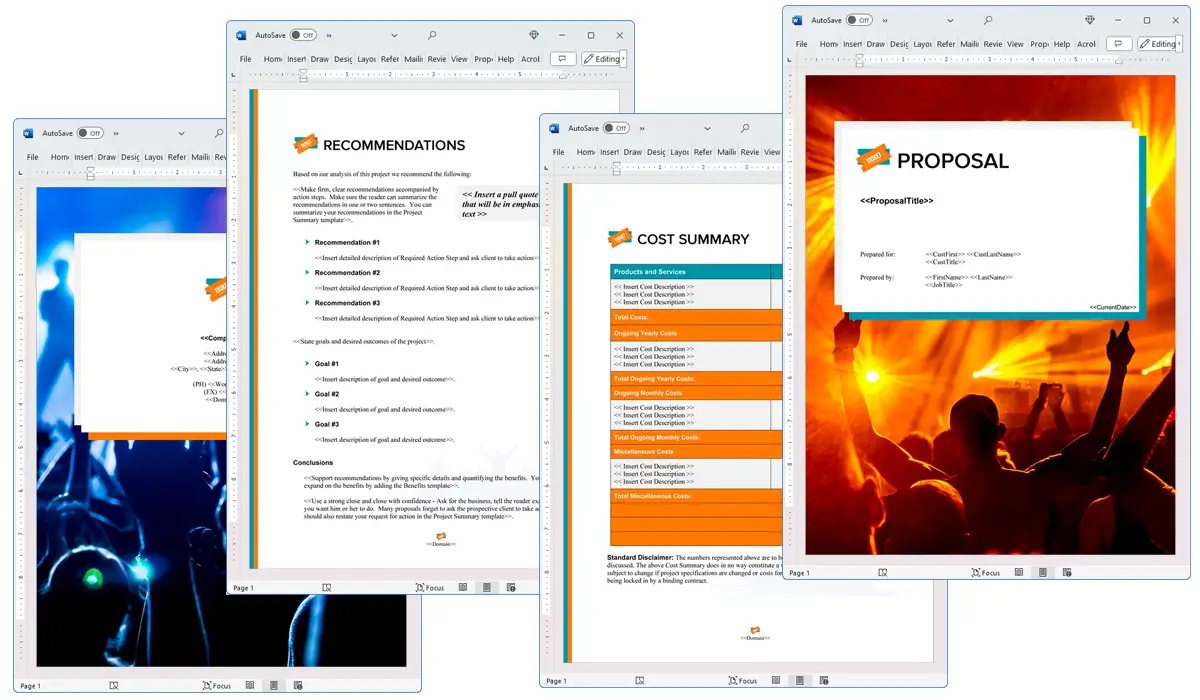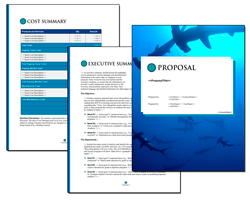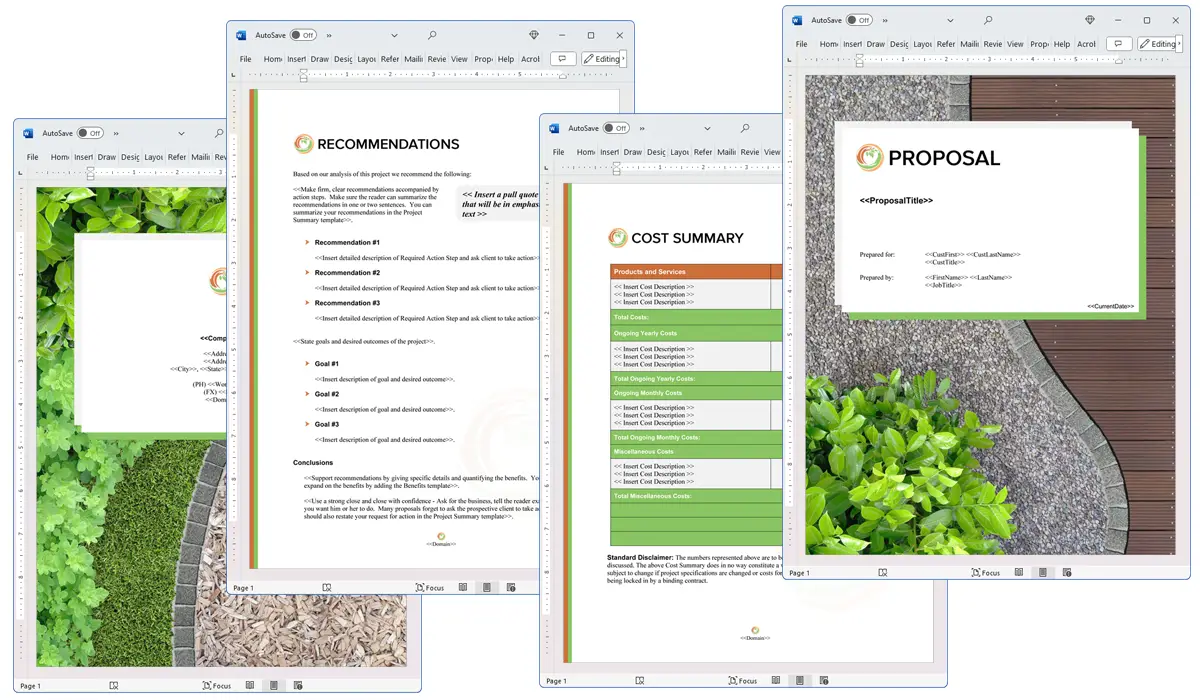What is the Course of Action chapter used for?
Proposal Kit Professional Bundle adds more design themes, all six Contract Packs,
a project management library, and Expert Edition software.

Illustration of Proposal Pack Events #7
We include this Course of Action chapter template in every Proposal Pack, along with thousands more. You assemble this chapter with others in various combinations to create custom-tailored business proposals, plans, reports, and other documents. Proposal Packs apply custom visual designs to the templates, giving the final documents a consistent professional finish.
 DOWNLOADABLE, ONE-TIME COST, NO SUBSCRIPTION FEES
DOWNLOADABLE, ONE-TIME COST, NO SUBSCRIPTION FEES
Overview of the Course of Action Chapter
The Course of Action chapter is a vital component in creating a comprehensive business proposal. This chapter allows the writer to outline the specific steps that will be taken to achieve the project objectives. It serves as a roadmap, detailing the planned activities and strategies. By integrating this chapter into a proposal, businesses can clearly communicate their plan of attack, which can be instrumental in persuading clients or stakeholders of the project's viability and the thoughtfulness of the approach.
How is the Course of Action Chapter Used?
When used in a business proposal, the Course of Action chapter is used to delineate the sequence of steps that the organization intends to follow to bring a project to fruition. This chapter is typically placed after the introduction and statement of need, where it builds on the context provided by explaining the practical steps the business will take to address the needs or opportunities previously outlined. It's a element that connects the proposal's goals to actionable steps, ensuring that the reader can visualize the transition from concept to reality.
What is Included in the Course of Action Chapter?
The Course of Action chapter typically encompasses several key elements:
- Background Information: Briefly revisits the project's purpose and significance, setting the stage for the detailed action plan.
- Detailed Action Steps: Lists and explains the specific actions that will be taken. This section is often organized as a timeline or a series of phases.
- Resources Required: Identifies what resources (time, talent, money) will be needed to carry out each action step.
- Anticipated Challenges: Discusses potential obstacles that could arise during the project's execution and suggests mitigating strategies.
- Expected Outcomes: Describes the anticipated results of each action step, reinforcing how this approach will help achieve the project's overall objectives.
Use Case Examples for the Course of Action Chapter
- New Product Launch: Outlining the steps for market research, product development, marketing strategies, and distribution.
- Business Expansion: Detailing the phases of market analysis, location scouting, hiring new staff, and marketing for a new regional office.
- IT System Upgrade: Laying out the timeline for system audit, data backup, hardware and software upgrades, and employee training.
- Event Planning: Describing the sequence of actions for venue booking, vendor contracts, event promotion, and day-of-event logistics.
- Research Project: Enumerating the stages of literature review, hypothesis formulation, experimentation, and result publication.
Key Takeaways
- Clarity and Direction: The Course of Action chapter provides a clear roadmap of how the project will be executed.
- Detail-Oriented: It includes comprehensive details about the steps, resources, and anticipated challenges, enhancing the proposal's credibility.
- Strategic Placement: This chapter builds on the introductory sections by linking goals to specific, actionable steps.
- Customizable: The chapter can be tailored to fit a wide range of industries and project types, making it a tool in proposal writing.
- Outcome-Focused: By anticipating the outcomes of each action, the chapter helps stakeholders understand the potential success and impact of the project.

Illustration of Proposal Pack Nature #11
 What Our Clients Say
What Our Clients SayUsing the Proposal Pack Wizard is a very easy and effective way to write an impressive proposal. I would recommend it to anyone who likes to make this chore a very easy to perform task. You will not be disappointed."
 4.7 stars, based on 847 reviews
4.7 stars, based on 847 reviewsRelated Chapters

The Course of Action chapter and other chapters are integrated into a Word document as illustrated here in the Proposal Pack Lawn #4 design theme. There are hundreds of design themes available, and every design theme includes the Course of Action chapter template.
A proper business proposal will include multiple chapters. This chapter is just one of many you can build into your proposal. We include the complete fill-in-the-blank template in our Proposal Pack template collections. We also include a library of sample proposals illustrating how companies in different industries, both large and small, have written proposals using our Proposal Packs. This template will show you how to write the Course of Action.
We include a chapter library for you to build from based on your needs. All proposals are different and have different needs and goals. Pick the chapters from our collection and organize them as needed for your proposal.
Using the Proposal Pack template library, you can create any business proposal, report, study, plan, or document.
The Wizard software includes an AI Writer, which will write the content of this and any other chapter of your document. Use the AI Writer to do the heavy lifting, writing the first draft of your proposal or business document in minutes.
 Ian Lauder has been helping businesses write their proposals and contracts for two decades. Ian is the owner and founder of Proposal Kit, one of the original sources of business proposal and contract software products started in 1997.
Ian Lauder has been helping businesses write their proposals and contracts for two decades. Ian is the owner and founder of Proposal Kit, one of the original sources of business proposal and contract software products started in 1997.By Ian Lauder
 Published by Proposal Kit, Inc.
Published by Proposal Kit, Inc.


 Cart
Cart
 Facebook
Facebook YouTube
YouTube Bluesky
Bluesky Search Site
Search Site